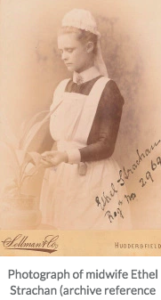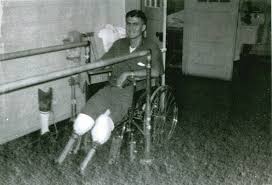https://tinyurl.com/yaw5795v
Dr. JWW’s story goes on but unfortunately for him, the numbers don’t lie!

Typical 1940-60s delivery room scene. Mother under general anesthesia, profoundly depressed baby that is not breathing in doctor’s hands as all 3 doctors and the nurse looks on
Generally, American obstetricians were well aware that Sweden had remarkably superior maternal-infant outcomes, so much so that one of the early influential leaders in obstetrical medicine (Dr. George Kosmak) went to Sweden to study their system.
When Dr. Kosmak returned from Sweden, he recommended that the American system adopt similar model, as it was associated with a dramatically reduced rate of maternal and infant deaths. However, that was not well received by American obstetricians since the Swedish maternity system for healthy women was based on professionally-trained midwives, with referral to general practice doctors if medical evaluation or treatment became necessary and transfer by the MD to the obstetrical unit of a regional hospital if aCesarean surgery was necessary. In the Swedish system, obstetricians ONLY provide care to pregnant women diagnosed with high-risk pregnancies and those who develop serious complications.
Obviously, that would never fly here, since the PR machine for organized medicine was busy having midwives arrested and criminally prosecuted for the illegal practice of medicine.
The US never made any scientific attempt to study the potential differences between the classic model of physiological support and spontaneous childbirth and the obstetrical model of routine interventions and surgical procedure of ‘delivery’. This this was quite a different story in Sweden.
The Swedes kept meticulous health records for its entire population going back nearly 200 years and their maternal mortality statistics shed very bright and incontrovertible light on this controversy. Unlike the US, they had a national program for the training of midwives and professional midwifery was identified by the Swedish government as the standard of care for healthy childbearing women.
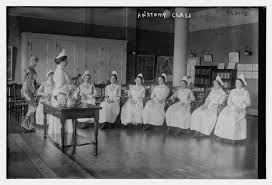
Swedish training program for professional midwives
As long as things were normal, babies were born at home under the care of a professionally-trained midwife. Anytime the midwife believed it necessary or prudent to call the local physician, he was obliged to come. If he thought it necessary, the mother was transferred to a district hospital that had obstetrical services.
In 1881 — the same year the French microbiologist Louis Pasteur’s Germ Theory of infectious disease was published and internationally-recognized — the Swedish Parliament passed a law requiring midwives and physicians that attended “cases of childbirth” to regularly and scrupulously wash their hands, abide by the principles of antisepsis and sterilize any instruments used during childbirth.
Unfortunately, no laws of this kind were passed in the US during this same period.
In 1900, the MMR in Sweden was only 230 per 100,000 births (or a ratio of 1:431).
{**Explaining “ratio” (1:431) statistics: the smaller the second number is, the more mothers are dying. It’s the same as using injury-accidents statistics to calculate how many times you can drive your car without being in hurt in an accident. If its 1 out of a 1,000, that’s good, but if its only 1 out of 10 times you get behind the wheel, that’s bad and you’ll probably have a serious car accidents 2 or 3 times a month.}
By comparison, the United States reported 520 to 850 maternal deaths per 100,000 live births (ratio of 1:127) or 3.4 times higher. One doctor of the era noted that our death rate for new mothers was the highest in the entire western hemisphere except for Brazil. 3
“As to maternal mortality, …during 1913 about 16,000 women died..; in 1918, about 23,000…and with the 15% increase estimated by Bolt, the number during 1921 will exceed 26,000.” [Ziegler, MD 1922-A]
A document published by the CDC on maternal mortality reported that our MMR was very high compared when with the lower rates achieved in much less prosperous European countries. The very highest MMR ever recorded in the US occurred between the years 1900 and 1932.
The CDC paper notes that:
“… the majority of these deaths were preventable” {due to} “obstetric care by poorly-trained and untrained medical practitioners. Inappropriate and excessive surgery and obstetrical interventions (e.g. induction of labor, use of forceps, episiotomy, cesarean section) were common during the 1920s”.
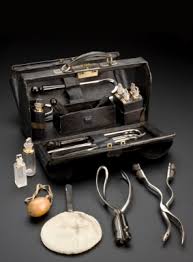
Doctor’s bag w/ two different kinds of obstetrical forceps. Note two glass bottles of liquid — one is drop ether and the other is chloroform anesthesia
This horribly high MMR precisely lines up with the obstetrical campaign championed by Dr. JWW to hospitalize increasing numbers of childbearing women in the US. Before the discovery of antibiotics, a fatal infection called childbed fever (septicemia) was the single most frequent killer of new mothers.
This is a known complication of unnecessarily hospitalizing healthy women, most especially if combined with routinely using invasive procedures the frequently lead to hemorrhage, which damages her immune system and makes her more vulnerable to bacterial infection. In other words, these deaths were primarily iatrogenic (caused by unnecessary or poorly performed medical treatments) or nosocomial (the result of the hospital’s bio-hazardous environment).
Two years after implementation of Dr. JWW’s Plan (1916) to electively hospitalized healthy childbearing women as maternity patients the MMR was 800 per 100,000 (1:125). In 1925 (9 years later) it shot up to 1,250 per 100,000 (1:80). This is 4,050 totally preventable maternal deaths in just nine years.
Numbers Don’t Lie ~ but tell us how many mothers die
If judged by the same statistics for the MMR in Sweden’s midwifery system 25 years earlier (1900) and using an averaged rate based for the United States MMR spread from its low in 1900 of 750 per 100k to its high in 1925 of 1,250 per 100K, we get an average MM rate for the US over those 25 years of 1,000 maternal deaths per 100K.
By subtracting the 232 maternal deaths per 100K rate in Sweden during this same time, the number of “extra” deaths in the US (i.e, higher than the Swedish system) is 768 per 100K. When we multiply that rate by 20 (the annual birth rate in the US was 2 million, which = 20 sets of 100,000) and multiply that number by the 32-year long period that the US had the highest MMR in our history, we find a total of 245,760 medically-unnecessary maternal deaths that exactly coincide with the period of medically-managed childbirth as the ‘hot new thing’ in obstetrics.
This highly contrasts with the MMR for the same historical period for the professional midwifery system in Europe that was still relying on the time-tested physiologically-based childbirth practices in concert with access to obstetrical services when indicated.

Typical forceps delivery with mother under general anesthesia. In this anti-gravitational position, the doctor has to pull straight up towards the ceiling) to get the baby to be born. If the mother was conscious and able to be upright right use of gravity), she would be able to push the baby down and out without the use of forceps
Nonetheless, the obstetrical profession, using it’s a money-fueled PR machine, managed to convince the public that the sky-high MMR in the US was all the fault of midwives and a few old-fashioned doctors who were still attending homebirths and doing everything the old/wrong way. Spokesmen for the obstetrical profession insisted that only doctors with training in obstetrical surgery should attend births; therefore, any midwife who attended a birth was engaged in a criminal act.
National newspaper and magazine articles quoted influential obstetrical leader as insisting that if 100% of childbearing women could be convinced to have hospital births, it would virtually eliminate these preventable deaths. Worse yet, they used these horrifically high statistics as part of a campaign strategy to promote elective hospitalization of maternity patients as so much safer.
I recently heard a radio interview of someone living in California who frequently flew back and forth to the east coast. He said he was no longer willing to do this, noting that “United is the airline that never apologizes no matter what they do“.
Apparently, the airlines and all five presidents and the Army generals that masterminded the Vietnam War were all reading out of the obstetrical profession’s playbook, since the profession never ever admits it was wrong, never says ‘sorry’ and no matter how much overwhelming scientific evidence its presented with, it never agrees to end harmful practices but instead just doubles down! {check out the ARRIVE study being used to set a new standard that routinely induces labor at 39 wks for healthy pregnant women}
 Preventable Injury & Death: What the war in Vietnam and the war on normal childbirth had in common
Preventable Injury & Death: What the war in Vietnam and the war on normal childbirth had in common
The take-home message is pretty simple. During the same pre-antibiotic era (prior to 1938), Swedish midwives within a system that provided assistance by local doctors when needed, had a ratio of maternal mortality was one of the lowest in the world in 1900 – 1 death out for every 431 births.
At that time (1900) the US rate MMR was approximately 1 out of 125 or 3.4 times higher. By 1916, the US mortality rate had increased slightly to 1 out of 127.
But by 1925 (just 9 years), the MMR had skyrocketed to 1 maternal death out of every 80 births or 5.4 times higher than Swedish midwives in 1900.
Imagine the uproar if the United States had 5.4 times more passenger planes crashed than any other countries. Given that the laws of aerodynamics are the same the world over, there surely would be outrage and inquiry and demands to ‘fix the problem’.
But these mothers died one by one by one with only their husbands and their older children and family members as grieving witnesses. There was no inquiry because they died in a hospital; this was interpreted to mean that childbirth itself was so dangerous that even the best doctors and all the extraordinary abilities of a modern hospital were not enough to save them from the wanton viciousness of Mother Nature.
In a most disturbing way, these deaths made obstetricians into heroes that were being lauded for saving the lives of thousands of healthy childbearing women every year.
BLACK News ~ 2 years of OB mismanagement produced as many maternal deaths as all soldiers that died in the Vietnam War
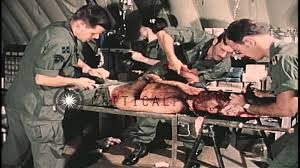 The unnecessary military “intervention” we call the Vietnam War killed 50,000 of the 2,709,918 Americans soldiers that served in Vietnam over 11 years (1964-1975).
The unnecessary military “intervention” we call the Vietnam War killed 50,000 of the 2,709,918 Americans soldiers that served in Vietnam over 11 years (1964-1975).
The MMR in the US for maternity patients for just two years — 1924-25 — was equal to the 50,00 deaths in the bloody 11-year Vietnam War.
The maternal death ratio during this period was only slightly lower (1:80) than that of US soldiers killed in Vietnam (1:54).
Thank you, Dr. Williams, for your good intentions, but unfortunately, things went about as wrong as they possibly could and the disturbing story is a long way from being over.
https://tinyurl.com/y8udohl6
https://www.cdc.gov/mmwr/preview/mmwrhtml/mm4838a2.htm
Addition quotes from Historical Documents
The citation number at the end of each paragraph includes the year (ex. 1397) and a letter (1937-A). This combination of numbers and letters will permit interested readers to find the specific document’s name. Unfortunately, a very large number of these references are from the Transactions for the American Association for the Study and Prevention of Infant Mortality {TAASPIM}.
There were 5 of these national meeting attended by all the movers and shakers of the American obstetrical profession. As far as I know, these transcripts are not available on the internet. I had to type them into a WORD program in order to post excerpts of them online.
Here is the LINK to access the Citation Key
Ø “We have had a small but convincing demonstration by the Frontier Nursing Service of Kentucky of what the well-trained midwife can do in America. …. The midwives travel from case to case on horseback through the isolated mountainous regions of the State. There is a hospital at a central point, with a well-trained obstetrician in charge, and the very complicated cases are transferred to it for delivery”. [1937-A]^136
Ø “In their first report they stated that they have delivered over 1000 women with only two deaths — one from heart disease, the other from kidney disease. During 1931 there were 400 deliveries with no deaths. Dr. Louis Dublin, President of the American Public Health Association and the Third Vice-president and Statistician of the Metropolitan Life Insurance Company, after analyzing the work of the Frontier Nurses’ midwifery service in rural Kentucky, made the following statement on May 9, 1932:
Ø “The study shows conclusively that the type of service rendered by the Frontier Nurses safeguards the life of the mother and babe. If such service were available to the women of the country generally, there would be a savings of 10,000 mothers’ lives a year in the US, there would be 30,000 less stillbirths and 30,000 more children alive at the end of the first month of life.”
Ø “What are the advantages of such a system? It makes it economically possible for each woman to obtain expert delivery care because the expert midwife is less expensive than an expert obstetrician.
Midwives have small practices and time to wait; they are expected to wait; this what they are paid for and there they are in no hurry to terminate labor by ill-advised operative haste.” [1937-A] {*}
END of this 8-part series
